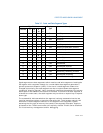
3-12 Vol. 3
PROTECTED-MODE MEMORY MANAGEMENT
3.4.4 Segment Loading Instructions in IA-32e Mode
Because ES, DS, and SS segment registers are not used in 64-bit mode, their fields
(base, limit, and attribute) in segment descriptor registers are ignored. Some forms
of segment load instructions are also invalid (for example, LDS, POP ES). Address
calculations that reference the ES, DS, or SS segments are treated as if the segment
base is zero.
The processor checks that all linear-address references are in canonical form instead
of performing limit checks. Mode switching does not change the contents of the
segment registers or the associated descriptor registers. These registers are also not
changed during 64-bit mode execution, unless explicit segment loads are performed.
In order to set up compatibility mode for an application, segment-load instructions
(MOV to Sreg, POP Sreg) work normally in 64-bit mode. An entry is read from the
system descriptor table (GDT or LDT) and is loaded in the hidden portion of the
segment descriptor register. The descriptor-register base, limit, and attribute fields
are all loaded. However, the contents of the data and stack segment selector and the
descriptor registers are ignored.
When FS and GS segment overrides are used in 64-bit mode, their respective base
addresses are used in the linear address calculation: (FS or GS).base + index +
displacement. FS.base and GS.base are then expanded to the full linear-address size
supported by the implementation. The resulting effective address calculation can
wrap across positive and negative addresses; the resulting linear address must be
canonical.
In 64-bit mode, memory accesses using FS-segment and GS-segment overrides are
not checked for a runtime limit nor subjected to attribute-checking. Normal segment
loads (MOV to Sreg and POP Sreg) into FS and GS load a standard 32-bit base value
in the hidden portion of the segment descriptor register. The base address bits above
the standard 32 bits are cleared to 0 to allow consistency for implementations that
use less than 64 bits.
The hidden descriptor register fields for FS.base and GS.base are physically mapped
to MSRs in order to load all address bits supported by a 64-bit implementation. Soft
-
ware with CPL = 0 (privileged software) can load all supported linear-address bits
into FS.base or GS.base using WRMSR. Addresses written into the 64-bit FS.base and
GS.base registers must be in canonical form. A WRMSR instruction that attempts to
write a non-canonical address to those registers causes a #GP fault.
When in compatibility mode, FS and GS overrides operate as defined by 32-bit mode
behavior regardless of the value loaded into the upper 32 linear-address bits of the
hidden descriptor register base field. Compatibility mode ignores the upper 32 bits
when calculating an effective address.
A new 64-bit mode instruction, SWAPGS, can be used to load GS base. SWAPGS
exchanges the kernel data structure pointer from the IA32_KernelGSbase MSR with
the GS base register. The kernel can then use the GS prefix on normal memory refer
-
ences to access the kernel data structures. An attempt to write a non-canonical value
(using WRMSR) to the IA32_KernelGSBase MSR causes a #GP fault.


















